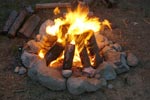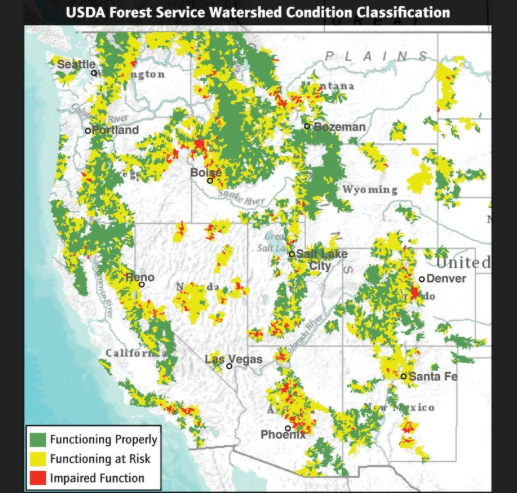BAILEY HEALTHY FORESTS INITIATIVE
For a Fire Adapted Community

A Fire Adapted Community takes responsibility for its wildfire risk. Actions address resident safety, homes, neighborhoods, businesses and infrastructure, forests, parks, open spaces, and other community assets. The more actions a community takes, the more fire adapted it becomes.

How does a community become fire adapted?
Becoming a fire adapted community is a process and includes the following characteristics:
Jill Ozarski (of Senator Mark Udall’s office), shared information on the Udall-Inhofe Fire Mitigation bill, which Senator Udall introduced last week. “We believe this program could be a game-changer for wildfire mitigation in Colorado, and appreciate all of your support as it moves forward,” Jill said. The bipartisan bill, co-sponsored by Jim Inhofe (R-Okla.), would allow FEMA to proactively work with states and localities on wildfire mitigation projects, and would allow states including Colorado to be eligible to receive an additional 15 percent of the total FEMA allocates for fire suppression and mitigation. See below for the press release and the bill.

From: U.S. Senator Mark Udall
Sent: Wednesday, April 04, 2012 5:20
Subject: Be prepared for wildfire
| Dear Fellow Coloradan,The wildfire season is off to an early and devastating start in Colorado. In the past few weeks, we have seen tragic fires, including the Lower North Fork Fire in Jefferson County and the Heartstrong Fire on the plains of Yuma County. And with Colorado State University climatologists estimating drought conditions in 98 percent of our state, it is even more important for Coloradans to help prevent and be prepared for wildfire. I encourage you to take these three proactive steps to protect your homes and communities from wildfire:
1. Recreate Responsibly: Err on the side of caution. Don’t leave campfires unattended, think before doing anything that could cause a spark in the backcountry and avoid outdoor burning. Be aware of fire risk by watching for posted warnings, and take responsibility for obeying restrictions in your area. 2. Prepare Your Property for Fire: If you live in a high-risk area, you can take precautionary steps to protect your home from fire, such as installing fire-resistant roofing and creating a safety zone around your home, including carefully storing firewood and other flammable objects. But one of the most important steps is removing leaves, pine needles and other flammable material from your home’s foundation. If you live in a wildfire-prone area, the most important yard tool is not necessarily a chainsaw; it’s a rake and a weed-whacker. 3. Prepare in Advance for Evacuation: Hundreds of homes have already been evacuated early in this season, and it can be a harrowing process. Families can cut down on stress by building an emergency kit and making a family communications plan that ensures the safety of people and essential belongings. If you have neighbors who are elderly or have special needs, consider them in your plans too. Last year, I requested a scientific study on the 2010 Fourmile Canyon fire in Boulder County. The resulting U.S. Forest Service report lays out the factors that influenced the most expensive fire in Colorado history so that our government agencies and homeowners can better prepare for future fire emergencies. The report contains some valuable advice for Coloradans whose homes are located in areas at high risk for wildfire. Having access to good information is key to being prepared for wildfire. That’s why I am also joining Governor John Hickenlooper, Senator Michael Bennet and Congressman Mike Coffman in calling for an after-action review of the Lower North Fork Fire. Wildfire season usually starts much later in the year in Colorado, and the dry and gusty conditions that fueled both the Lower North Fork Fire and the Heartstrong fire are warning signs that it may be a very long firefighting season. Please take the time now to get ready, and stay safe this wildfire season. Best regards, P.S. If you live in the Wildland Urban Interface, take the Firewise Quiz: http://www.firewise.org/Information/Firewise-Quiz.aspx |
||||

In a recent article titled, “Front Range Forest Thinning May be Misguided,” researcher William Baker and Mark Williams of the University of Wyoming indicate that “current efforts to uniformly thin Front Range ponderosa forests and reduce fire intensity may be misguided and may not restore them. Instead, the aggressive management could take even farther from the natural historic range of variability with potential negative consequences for wildlife”.
This is an important addition to the research available regarding the management of our forests; however, the scientific community has already realized that the goals of forest management just for fuels reduction and wildfire protection was not ideal. Today, the discussions relating to forest management focus on the concept of restoration. Forest restoration seeks to protect forests by learning from the past, and managing forests for diversity of species, resiliency to disease and insects and fire.
To view the article in the Summit County Citizens voice Click Here.

Here is a link to an article from the High Country News, titled “Communities help pay for ecosystem services provided by forests”
Within this Article, Nell Rubbio, discusses how water providers are kicking in to help protect forested land in the west.
From the Denver Post